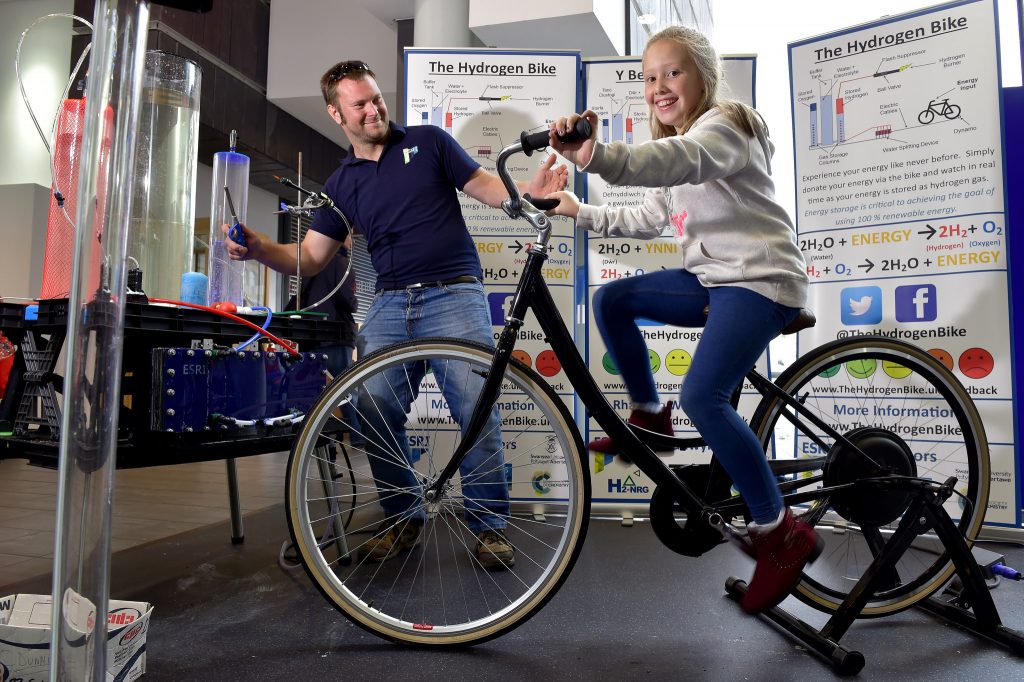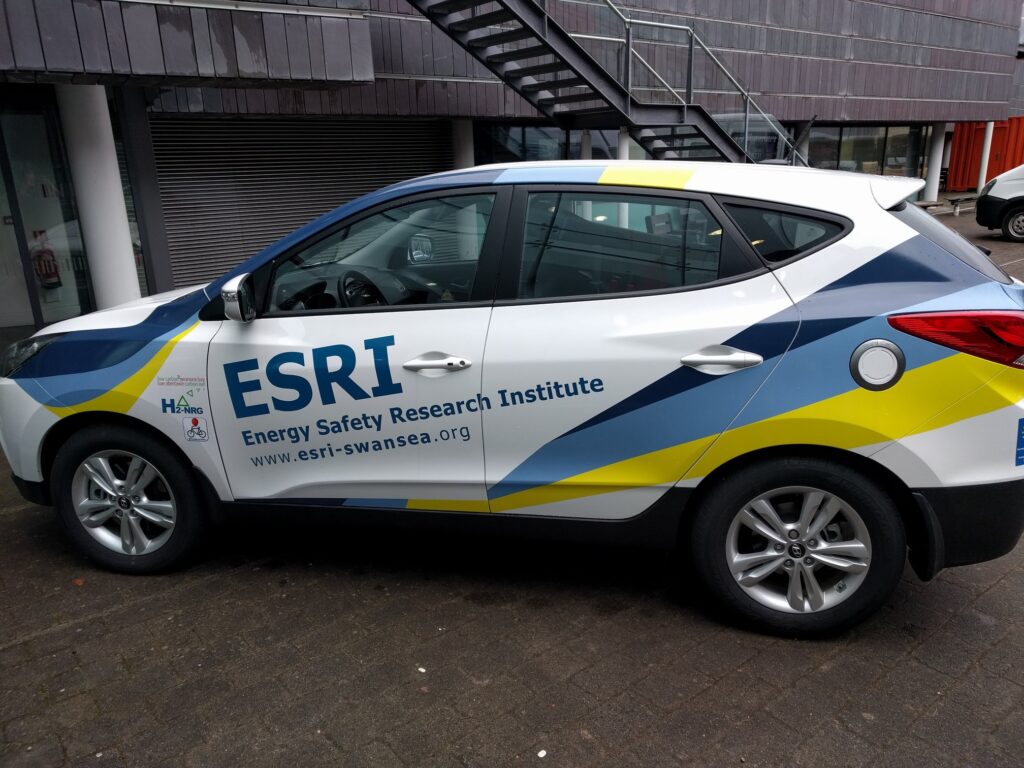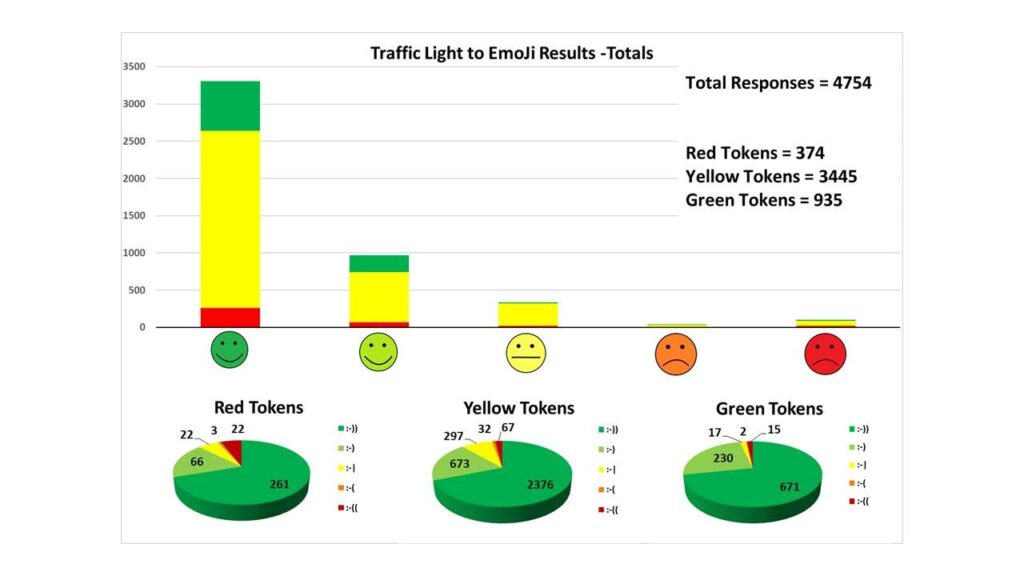Breaking Down Barriers to Green Hydrogen
Modernising public policy for clean growth is critical to achieving Government’s ambitious 2050 net-zero targets. Public policy is driven by public perception, making it vitally important to engage the public on the journey towards a low carbon future.
FLEXIS researchers at Swansea University are using a novel public engagement activity to demonstrate the power of low carbon energy systems. Enter; ‘The Hydrogen Bike’.

Dr Charlie Dunnill and a student using the Hydrogen Bike
Green hydrogen has the potential to immediately decarbonise some of the largest sources of emissions in today’s modern world; from replacing petrol and diesel in vehicles, providing an alternate fuel source for heavy industrial processes or replacing methane in central heating boilers used to heat our homes and hot water. Hydrogen is also an energy storage solution that can be used to store energy from renewables when there is low demand and release it at times when the wind stops blowing or sun is not shining.
A problem of perception, or lack thereof
Despite all the opportunities, adoption of green hydrogen has been slow over the last decade. Some people’s immediate reaction to hydrogen manifests as fear, recalling events such as the Hindenburg zeppelin disaster or past safety fears over British Town Gas of the post-war decades. However, it is rather that the public are largely unaware or indifferent to the use of hydrogen as an energy vector which is stalling progress.
Hydrogen simply does not play a visible role in our everyday lives in the same way that other energy vectors do, like turning up the gas central heating, seeing wind turbines in the distance or filling up the car.
To address this challenge, Dr Charlie Dunnill and his team devised a way to communicate the potential of green hydrogen to policy makers and the public alike. The Hydrogen Bike is an interactive demonstration of how renewable energy can be transformed into hydrogen and then used to power the world around us. Their aim was not only to positively impact public perception on hydrogen as a renewable energy storage solution, but also to explore how people’s opinion change following hands-on participation in science, technology, engineering and mathematics (STEM) activities.
How it works – People power
Members of the public provide their own energy by pedalling a stationary bike attached to an electric dynamo. The users get a tangible feeling of having to input energy to power the demonstration which makes for a memorable conversation starter long after the demonstration is over. It’s not uncommon to hear people at events enthusiastically say, “have you had a go on the Hydrogen Bike?” or “Yes! I’ve pedalled the bike”.
The electricity produced by the user and the bicycle, representing green electricity from wind or other renewable sources, is then used to power an alkaline electrolyser which splits water into hydrogen and oxygen gases. The ‘Dunnill Labs’ design and engineer these advanced low-cost, high-efficiency electrolysers as part of their ongoing research.
For many people, this is the first time they will ever have seen a flame burning without giving off carbon dioxide.
Dr Charlie Dunnill, Swansea University
The resulting hydrogen is used in two ways as part of the demonstration:
- to power a bank of LED lights via the hydrogen fuel cell
- to provide a safe and stable hydrogen flame.
The extension to how hydrogen can be part of everyday life is then easy to draw – fuel cell technology can power vehicles, street lighting, homes and businesses. Burning hydrogen can provide heating in the same way we use natural gas today, all without any carbon emissions. To really drive the message home, the team often present the Hydrogen Bike alongside the vehicle they use to transport the equipment; a Hyundai hydrogen fuel cell car.

ESRI Hydrogen Car
Making a measurable impact
Impact is measured via a 5-way interactive emoji token system. The conversation with participants begins with the question ‘How do you feel about hydrogen?’ and the participant is encouraged to self-assess their opinion based on a simple traffic light system. Participants with a negative view of hydrogen receive a red token, while those with a positive view receive a green. Participants with no knowledge or no opinion receive a yellow. This ensures a ‘baseline’ measurement. Participants hold their tokens throughout the display and then deposit it into tubes aligned with a 5 point emoji scale from ‘Very Happy’ to ‘Very Sad’, answering the question; ‘How do you now feel about a hydrogen powered future?’

Opinion Poll Graph
With nearly 5,000 participants taken part in the demonstration to date, the results are showing the Hydrogen Bike to have a profound impact on the perceptions of those who previously had an indifferent (yellow token) or negative (red token) opinion before the demonstration.
It was also important to see that prior to the demonstration, participants did not necessarily lean toward a negative view of hydrogen. In fact, only 8% perceived it negatively whereas the majority (72%) claimed to have no opinion. This is all important in addressing the challenge of adopting green hydrogen into public policy. Rather than fighting against existing negative perceptions, these figures show the main battle is in fact in raising awareness and exposure in the first place.
Having a go on the Hydrogen Bike left 89% of those who had no prior opinion with a positive perception of hydrogen power. Such a profound reaction from members of the public shows how effective hands-on interactive demonstrations are and why they should be part of public outreach activities whenever possible.
Fresh off the lab bench
Far too often, STEM outreach fails to incorporate real world research, instead relying on the ease and comfort of tried and tested concepts. However, these concepts are so far removed from modern research challenges that they fail to make an effective connection for participants to see how the demonstration relates to the real world. This also creates a false image of what people in STEM careers work on in a day to day basis. What is particularly special about the Hydrogen Bike demonstration is that it uses real-world research apparatus that is straight out of the laboratory – namely the novel hydrogen electrolyser made by The Dunnill Labs.
Dr Charlie Dunnill
The Hydrogen Bike has been a major attraction at many FLEXIS events during recent years, even getting pedal power from Welsh First Minister, Mark Drakeford, as well as several participants from BEIS and UK Government.
For many of these important policy makers, it was their first ever experience getting hands on with hydrogen energy. To date, the team have had approximately 20,000 conversations with members of the public across a huge range of backgrounds and demographics. Many of those were with young engineers and scientists at fairs such as The Big Bang, who will go on to be the generation that uses green hydrogen as a mainstream energy vector in their future adult lives.
With special thanks to the tireless efforts of those who have organised and run all the events where the Hydrogen Bike has featured.


